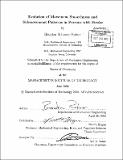Evolution of movement smoothness and submovement patterns in persons with stroke
Author(s)
Rohrer, Brandon Robinson, 1974-
DownloadFull printable version (5.263Mb)
Other Contributors
Massachusetts Institute of Technology. Dept. of Mechanical Engineering.
Advisor
Neville Hogan.
Terms of use
Metadata
Show full item recordAbstract
Smoothness is characteristic of coordinated human movements, and stroke patients' movements seem to grow more smooth with recovery. A robotic therapy device was used to analyze five different measures of movement smoothness in the hemiparetic arm of thirty-one patients recovering from stroke. Four of the five metrics showed general increases in smoothness for the entire patient population. However according to the fifth metric, the movements of patients with recent stroke grew less smooth over the course of therapy. This pattern was reproduced in a computer simulation of recovery based on submovement blending, suggesting that progressive blending of submovements underlies stroke recovery. Submovements are hypothesized fundamental building blocks of human movement. All available evidence is consistent with their existence and no other theory has been proposed that can fully account for observed phenomena in human movement. However, there is no obvious way to prove their existence. Nevertheless, repeatedly successful decomposition of movement data into submovements may produce sufficient evidence to make the question moot. The component submovements of stroke patients' point-to-point movements were estimated using a novel submovement extraction algorithm. Over the course of therapy, patients' submovements tended to increase in peak speed and duration. (cont.) The number of submovements employed to produce a given movement decreased. The time between the peaks of adjacent submovements decreased for inpatients (those less than 1 month post-stroke), but not for outpatients (those greater than 12 months post-stroke) as a group. Submovements became more overlapped for all patients, but more markedly for inpatients. This pattern of changes in the extracted submovement parameters 1) provides an objective basis for evaluating patients' state of motor recovery and 2) provides some degree of additional support for the existence of submovements.
Description
Thesis (Ph. D.)--Massachusetts Institute of Technology, Dept. of Mechanical Engineering, 2002. Includes bibliographical references (p. 163-172).
Date issued
2002Department
Massachusetts Institute of Technology. Department of Mechanical EngineeringPublisher
Massachusetts Institute of Technology
Keywords
Mechanical Engineering.